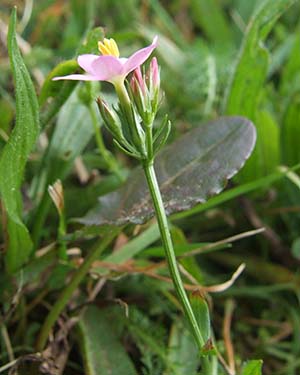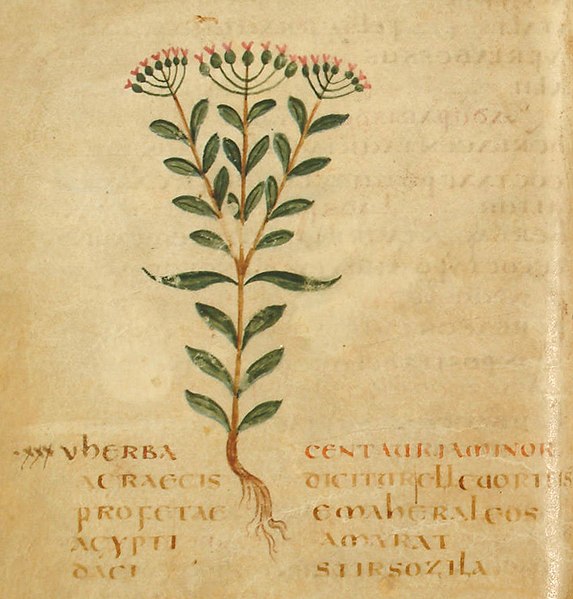We have a scattering of a pretty little plant called Centaury in our meadow – or we did have, until I mowed it at the end of last month.
But today, I happened to catch sight of this little chap, growing on a very small plant obviously making the most of the late summer warmth, probably from a seed sown before mowing:
What caught my attention was that it has six petals, whereas the European Centaury, Centaurium erythraea, consistently has only five. I searched in vain for similar six-petalled pink flowers in my field guide, but eventually the leaves, and the shape of the sepals, convinced me it was indeed a Centaury, but one evidently unable to count. For the botanists among you, here is the business end…
A search on the web found me a botanical discussion in which someone photographed similar flowers with six or seven petals in Lebanon, and after much multilingual discussion the conclusion was it must be C. erythraea in anomalous form, even though none of the experts had ever heard of such a thing. So I seem to be a bit privileged to have mine.
In fact, it isn’t the first anomalous Centaury I’ve seen here – this year and a decade or so ago there was a white-flowered plant growing in the field, which appears to be a rather more common variation. Who would have thought our field would be such a hotbed of evolution? The plant is annual or biennial, and as I was photographing it, I saw a hoverfly come and feed on it, so who knows, maybe I’ll see a whole strain of them appearing come next year, as was apparently the case on the Lebanon hillside aforementioned.
Whenever I write on a species here, I like to research what is of interest about it, as there is always something unique to be noted in all God’s creatures. I’ve always wondered about the name, and it appears to have acquired it because, in myth, Chiron the famous physician-centaur used it to heal a poisoned arrow wound. Hippocrates himself refers to it.
Centaury , a member of the gentian family, is indeed one of those plants that appears in every herbal, treating everything from snake-bite to stomach and liver complaints. One of its other names, Feverwort, indicates a role as an antipyretic, not to be confused with Feverfew, which also grows here. Maybe they work better in combination, as ibuprofen and paracetamol are reputed to do. That’s one to remember when the pharmacies begin to insist on vaccine passports…
Any medicinal value Centaury has appears to arise from a number of xanthine alkaloids and phenolic acids it produces. As so often is the case since Rockefeller molecularised medicine back in the nineteen twenties, little research has been done on this, but a plant that’s been in regular use across the world since classical times is unlikely to be useless. Here’s a sixth century illustration. I doubt theirs really had only two petals. But only mine, and the bloke in Lebanon’s, has six.




Interesting.
Your mention of the medicinal uses of Centaury reminded me that my dad used to make periwinkle ointment, and was rather proud of his concoction. I don’t recall what personal use he put it to (probably because he didn’t tell me), but I remember that for my siblings and me it was applied to sore skin – for insect bites and the like.
I looked up periwinkle today and, yes, it’s closely related to gentians. Five petals, though – no sixes (that I could find).
Well spotted!
I have a small wild-flower patch (a patch that I deliberately sowed – not a meadow – yet), and I have noticed a few late arrivals in the last couple of weeks; as you say, the recent warm weather has helped.
Periwinkles certainly found their way into conventional pharmacology, via vincristine and vinblastine, horribly poisonous drugs I used to inject into leukaemia patients in Poole General when I wasn’t injecting people with isotopes.
Your father’s work reminds me of a piece I wrote back in the World Medicine days that might amuse you. The way the NHS is going, it seems almost topical.
The only thing I’ve actually sown in our meadow is yellow rattle, which would have been there naturally before somebody maximised its grass production as a paddock. Each year we get new species colonising it, which is fascinating.